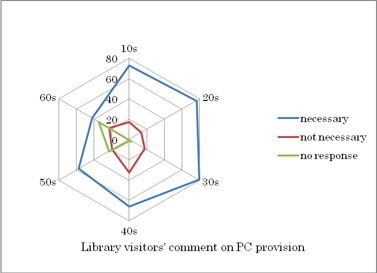Research on the Management of Municipal (City-Town-Village) Public Libraries
The activity of prefectural library has a strong correlation with the financial condition of its parent organization. On the other hand, the correlation between the municipal (City-Town-Village) library activities and the finance of the municipality is almost invisible. According to computation of the correlation coefficient between the financial indicators (financial capability indicator, current account ratio, local debt balance, and real debt expenditure ratio) and library activity indicators (library expenditure, collection size, and library space), the average correlation coefficients for prefectures range from 0.55 to 0.76. Those for municipalities are approximately 0.1. What this means is, even though the municipal library policy in principle has been affected by the budget, library activities do not always depend on the financial conditions of the local government in a city, town, or village.
Here the research is to examine the state of municipal public library management from various viewpoints.
(1) Library Service after the Amalgamation of Local Authorities
Based on the Atsushi Ikeuchi’s technique to find the optimal size of a public library*, we examined the basic library data of municipalities that had merged by 2004 (178 municipalities before amalgamation and 95 after). The Ikeuchi technique finds the optimal size by a regression estimation based on a three-dimensional function model between variables.
The result of this quantitative analysis shows that the optimal library size is realized within the top 10 largest libraries as indicated by the available research data. But it does not mean ‘the bigger, the better’. Regarding to the floor space and the library budget, the minimum values exceeded the optimal values. In the case that the optimal value is exceeded, there is a drop in efficiency. For the floor space, the optimal size varies depending on whether the main purpose is to minimize the expenditure or to maximize output of services.
The result also shows that it is more efficient to reduce the number of books after the amalgamation of local authorities. Consequently a single unit municipal library the number of staff of a town-village level library, and the floor space of a city-level library, should be reduced. For the municipal library (which consists of more than one unit) as a whole, it is more efficient to increase the floor space after the merger. Thus the result varies depending on the level and aspect.
City A in I Prefecture was able to maintain a value close to the optimal library size after amalgamation. Instead of measuring quantitative effects, we conducted a visitor survey to ascetain their awareness of library services in the city. This survey result suggests individual management points such as the system of service delivery and the attitude of librarians have influenced user satisfaction.
*Ikeuchi, Atsushi, Kokyo Tsohokan no Saiteki Kibo ni kansuru Jisshoteki Kenkyu. Library and Information Science, No. 46, 2001, p. 1-36.
(2) Reaction to Library Service Delivery
We examined the degree of gaps between the perception of visitors and library service delivery in City B City in T Prefecture. While a separate center (not a library) in this city is equipped with PCs, the library in question did not have any PCs. The figure gives a breakdown of visitors’ opinion given in percentages. Excluding visitors in their 60s, 60 to 80% of visitors feel that PCs is “necessary.”
With a library budget that is average for the prefecture, this city is not considered to be neglectful of its social education facilities. However, the city uses an outmoded library service model.

